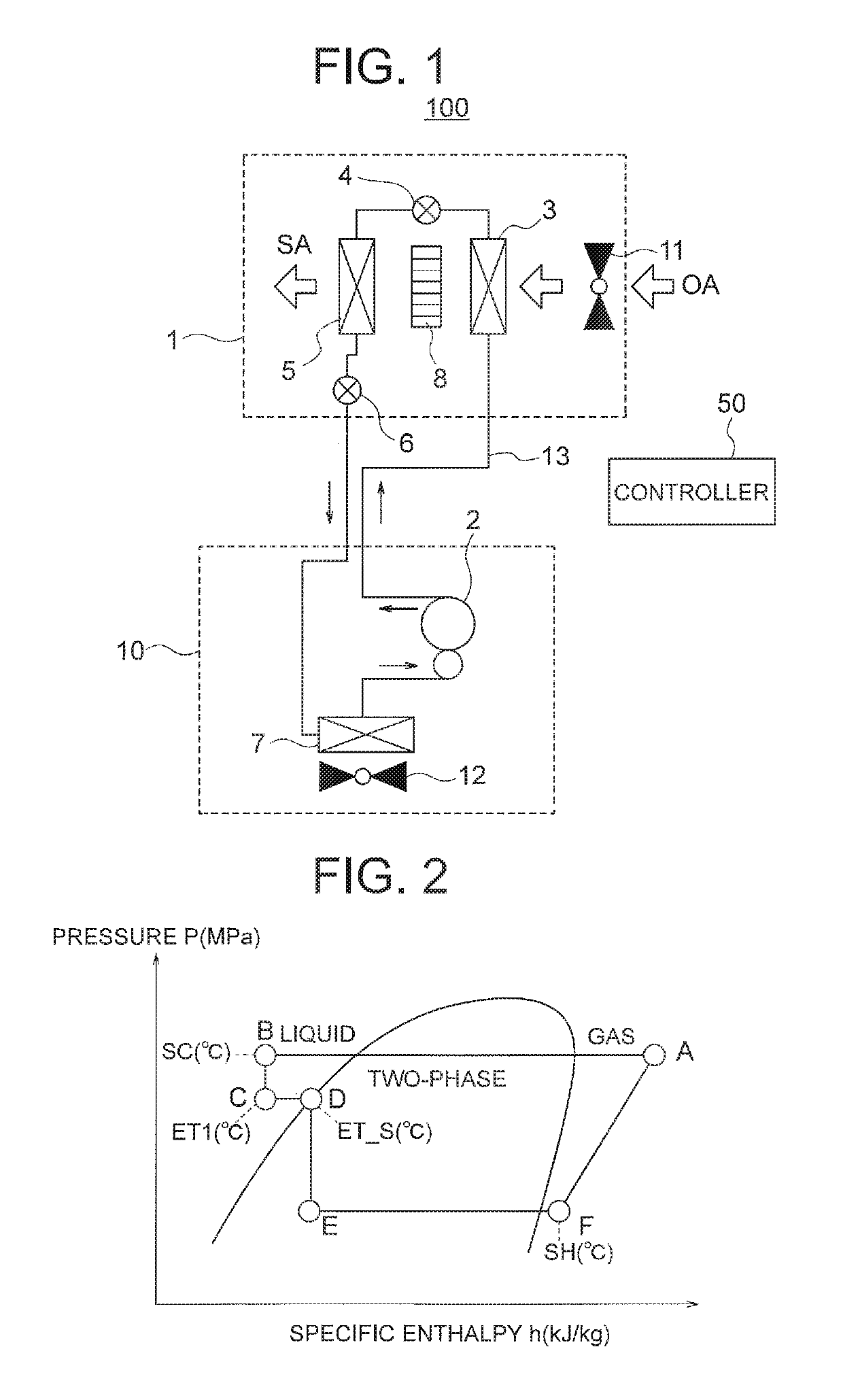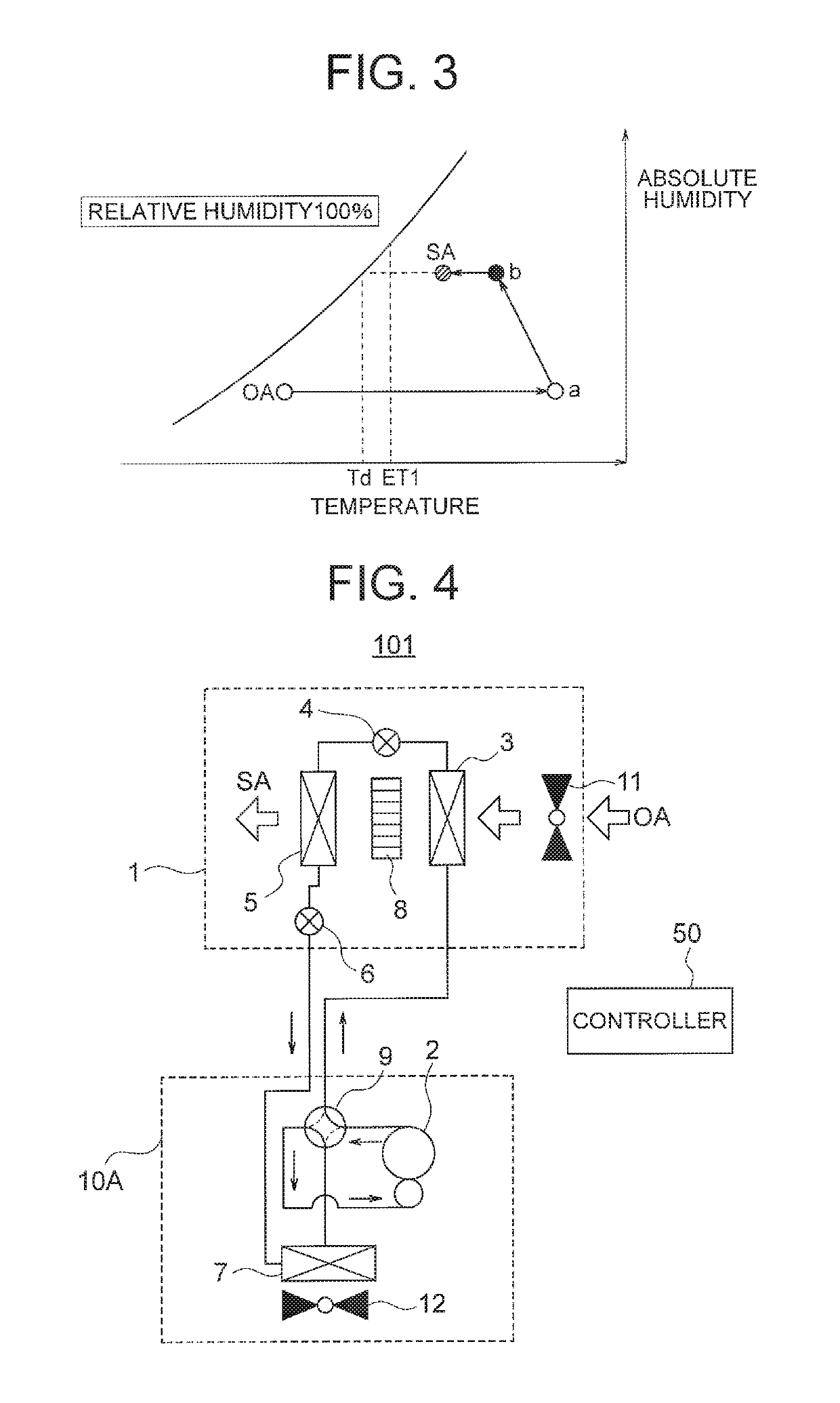Air conditioning system
a technology of air conditioning system and air flow, which is applied in the field of air conditioning system, can solve the problems of reducing room comfort and increasing cooling load, and achieve the effects of reducing the increase in the temperature of the blowing air, reducing the comfort of the room, and increasing the cooling load
- Summary
- Abstract
- Description
- Claims
- Application Information
AI Technical Summary
Benefits of technology
Problems solved by technology
Method used
Image
Examples
first embodiment
[0023]FIG. 1 is a diagram illustrating a configuration of an air conditioning system 100 according to a first embodiment of the present invention. The air conditioning system 100 takes in air outside a room and humidifies it, and supplies the humidified air into the room. The air conditioning system 100 includes an outside air processing unit 1, an outdoor unit 10, and a controller 50. The outside air processing unit 1 and outdoor unit 10 are connected to each other through refrigerant piping 13.
[0024]The outside air processing unit 1 includes a first heat exchanger 3 as a condenser, a first decompressor 4, a second heat exchanger 5 as a heat exchanger, and a second decompressor 6. The first heat exchanger 3 and second heat exchanger 5 are disposed to face each other. A humidifier 8 is disposed between the first heat exchanger 3 and the second heat exchanger 5.
[0025]An indoor blower fan 11 as a blower fan that takes in air from outside the room is disposed on a side of the first hea...
second embodiment
[0058]An air conditioning system 101 according to a second embodiment of the present invention will now be described. The above-described air conditioning system 100 of the first embodiment is configured to allow the refrigerant to circulate in one direction and perform the humidifying operation. In contrast, the air conditioning system 101 of the second embodiment is configured to be capable of switching a circulating direction of refrigerant and switching between a humidifying operation and a dehumidifying operation.
[0059]A configuration of the air conditioning system 101 of the second embodiment will now be described. FIG. 4 is a diagram illustrating the configuration of the air conditioning system 101 of the second embodiment and the flow of the refrigerant during the humidifying operation. In the air conditioning system 101 of the second embodiment, a four-way valve 9 as a flow path switching valve is provided on an outlet side of a compressor 2 of an outdoor unit 10A. The four...
third embodiment
[0084]An air conditioning system 102 according to a third embodiment of the present invention will now be described. The air conditioning system 102 of the third embodiment is obtained by adding a total heat exchanger 20 to the outside air processing unit 1 of the above-described air conditioning system 100 (101) of the first or second embodiment.
[0085]FIG. 7 is a diagram illustrating a configuration of the air conditioning system 102 of the third embodiment. An outside air processing unit 1A of the air conditioning system 102 includes a first airflow path 21 for introducing outdoor air (or air outside a room) OA, a second airflow path 22 for introducing indoor air (or air inside the room) RA, the total heat exchanger 20 that exchanges heat between the outdoor air OA and the indoor air RA, a third airflow path 23 for exhausting the indoor air RA flowing out of the total heat exchanger 20, and a fourth airflow path 24 for supplying the outdoor air OA flowing out of the total heat exc...
PUM
 Login to View More
Login to View More Abstract
Description
Claims
Application Information
 Login to View More
Login to View More - R&D
- Intellectual Property
- Life Sciences
- Materials
- Tech Scout
- Unparalleled Data Quality
- Higher Quality Content
- 60% Fewer Hallucinations
Browse by: Latest US Patents, China's latest patents, Technical Efficacy Thesaurus, Application Domain, Technology Topic, Popular Technical Reports.
© 2025 PatSnap. All rights reserved.Legal|Privacy policy|Modern Slavery Act Transparency Statement|Sitemap|About US| Contact US: help@patsnap.com



